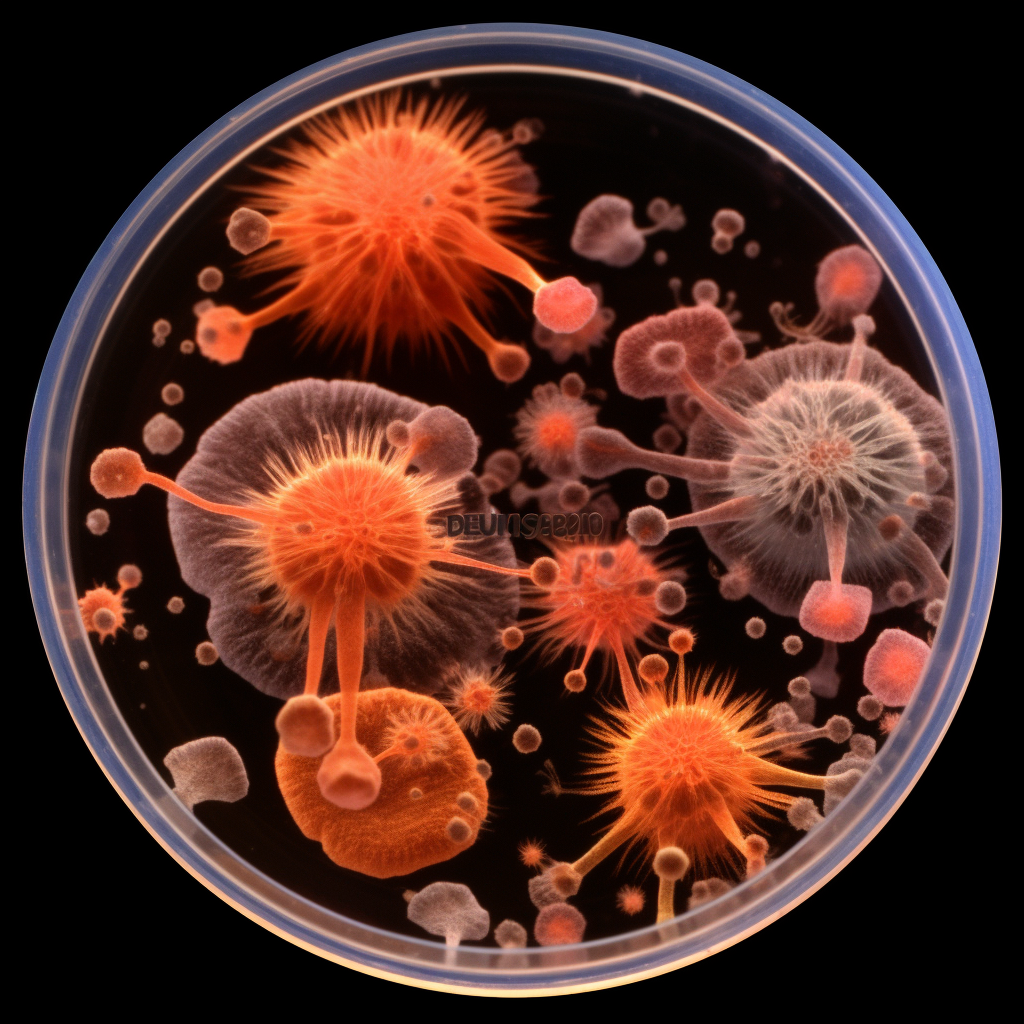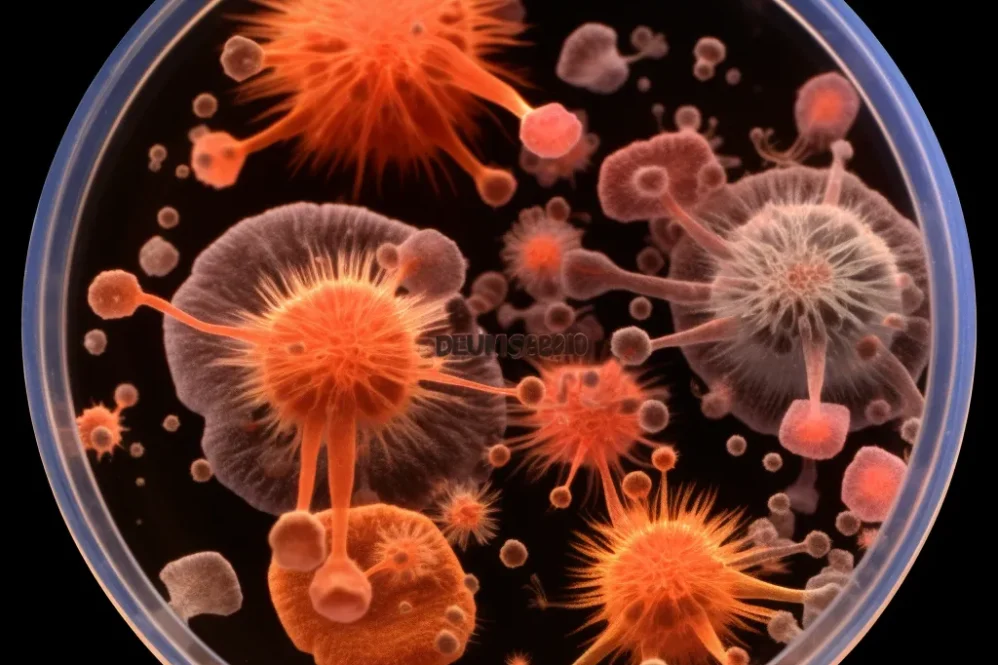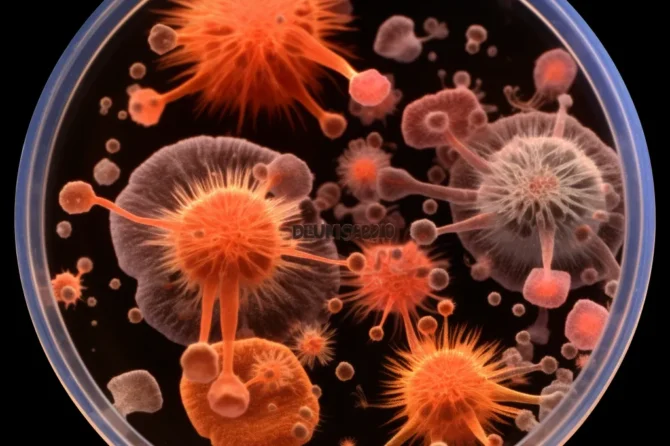Abstract:
Bacteriophages, as key players in shaping bacterial populations and influencing their behavior, have been shown to have a significant impact on Streptomyces bacteria, renowned for their production of specialized metabolites and complex developmental processes. This study presents a comprehensive analysis of twelve bacteriophages infecting Streptomyces coelicolor, a model organism for Streptomyces research. Through genome sequencing and comparative analysis, we unveil remarkable genome conservation among these phages, despite their diverse origins. Intriguingly, these genetically similar phages exhibit variable effects on their bacterial hosts, inducing alterations in colony morphology, secondary metabolite production, and sporulation acceleration. We propose that these phenotypic changes stem from the diverse accessory gene content carried by these phages.
By exploring the interplay between Streptomyces bacteria and their phages, this study offers enhanced insights into the phage-host evolutionary arms race, providing a deeper understanding of the co-evolutionary dynamics between these two entities. Furthermore, the observed variability in the effects of these phages on Streptomyces coelicolor sheds light on novel secondary metabolite production and their potential applications in biotechnology. The discoveries from this study hold promise for biotechnological applications, including the development of new antibiotics and other bioactive compounds produced by Streptomyces under phage influence.
Understanding the mechanisms underlying the diverse effects of these genetically similar phages on Streptomyces coelicolor will pave the way for harnessing the potential of bacteriophages in biotechnological applications. These findings contribute to the growing body of knowledge surrounding the interactions between bacteriophages and bacteria and hold implications for the development of innovative strategies in biotechnology, such as targeted manipulation of secondary metabolite production and enhancement of sporulation rates in Streptomyces. This research also underscores the importance of studying bacteriophage diversity and its influence on bacterial populations, providing valuable insights into the co-evolutionary dynamics between these microorganisms and presenting new opportunities for therapeutic and industrial advancements.
Introduction:
Streptomyces bacteria, belonging to the Actinobacteria phylum, have garnered immense interest in the scientific community due to their remarkable ability to produce a vast array of specialized metabolites with diverse biological activities. These metabolites, often referred to as secondary metabolites, include antibiotics, antifungals, immunosuppressants, and anticancer agents, among others. Their profound impact on drug discovery, agriculture, and various biotechnological applications underscores the importance of understanding the intricate biological processes of Streptomyces and the factors that modulate their metabolite production.
Streptomyces bacteria undergo complex developmental processes, leading to the formation of characteristic filamentous structures called hyphae, which ultimately culminate in the production of specialized metabolites. However, the regulation of secondary metabolite biosynthesis is a tightly controlled and intricate process, influenced by environmental factors, nutrient availability, and the interplay between various regulatory genes. Deciphering this regulatory network is fundamental for unlocking the full potential of Streptomyces in biotechnological applications and drug discovery.
In recent years, bacteriophages, the viruses that infect bacteria, have emerged as powerful tools for unraveling the genetics and physiology of Streptomyces. Bacteriophages that infect Streptomyces, also known as Streptomyces phages, have drawn attention as they offer unique insights into the interaction between these viruses and their bacterial hosts. By studying these phages, researchers can gain valuable information about the molecular mechanisms underlying Streptomyces biology, including the regulation of secondary metabolite production.
This study focuses on twelve Streptomyces phages to shed light on their genomic characteristics, host range, and the phenotypic changes they induce in their bacterial hosts. Understanding the genomic features of these phages, such as gene content, sequence homology, and genetic diversity, can provide insights into their evolution and potential interactions with Streptomyces. By examining their host range, researchers can determine the specificity of these phages in infecting different Streptomyces strains, shedding light on their potential applications as biocontrol agents in agriculture or biotechnological tools for targeted genetic manipulation.
Furthermore, investigating the phenotypic changes induced by these phages in their bacterial hosts is of paramount importance. It can reveal how these phages modulate the regulatory networks governing secondary metabolite production, colony morphology, and other critical aspects of Streptomyces biology. The findings from this study will not only contribute to our understanding of phage-host interactions but also offer valuable information for optimizing the production of specific metabolites in Streptomyces for biotechnological applications.
Overall, exploring the intricate relationship between Streptomyces bacteria and their phages holds immense potential in enhancing our understanding of microbial physiology and genetics. It also presents opportunities to harness Streptomyces’ prodigious capacity for specialized metabolite production for diverse applications in medicine, agriculture, and industry. The insights gained from this investigation may pave the way for novel strategies to improve drug discovery, develop sustainable agricultural practices, and address various challenges in biotechnology, underscoring the significance of studying the phage-bacterium interplay in Streptomyces.

Methods Used the Impact of Phage Infection on Streptomyces Bacteria:
In this groundbreaking research endeavor, our primary goal was to delve into the fascinating world of Streptomyces phages and unlock the secrets of their genetic makeup, infectious capabilities, and the intriguing phenotypic changes they induce in their bacterial hosts. To embark on this scientific journey, we began by collecting soil samples from diverse geographic locations, each offering a unique microcosm of microbial life. These soil samples acted as a treasure trove, housing a plethora of Streptomyces strains and, potentially, their viral adversaries, the bacteriophages.
To isolate the elusive phages from this vast microbial landscape, we employed sophisticated enrichment techniques, capitalizing on the distinct characteristics of various Streptomyces strains. These strains acted as bait, enticing the elusive phages to reveal themselves and establish a unique symbiotic relationship, which we aimed to study in-depth.
With the phages successfully captured and isolated, the next step was to propagate them, allowing us to obtain sufficient quantities for comprehensive analyses. High-throughput sequencing technologies served as our powerful tool, providing us with vast amounts of sequence data from the phage genomes. This genomic treasure trove held the key to unlocking the mysteries of these viral entities.
Through meticulous genome assembly, annotation, and comparative analyses, we embarked on an intriguing quest to uncover the genetic relatedness among these diverse phages. This involved identifying conserved genes and regions of similarity, offering a glimpse into the underlying genetic architecture that unites these viral agents despite their diverse origins.
One of the critical questions we sought to address was the infectivity of these phages across various Streptomyces species. For this purpose, host range determination and efficiency of plating experiments were conducted, allowing us to gauge the phages’ specificity and effectiveness in infecting different Streptomyces strains. This knowledge could prove instrumental in harnessing the phages’ potential as biocontrol agents or genetic manipulation tools.
To observe the phages’ dynamics during infection, we embarked on a mesmerizing journey through infection time-course experiments. This temporal exploration allowed us to monitor the rise and fall of phage titers over time, providing insights into the kinetics of phage replication and the impact of their presence on the bacterial hosts.
The captivating story did not end there; we further explored the captivating phenotypic changes induced by these phages in Streptomyces colonies. By subjecting the bacterial hosts to plate pinner assays, scanning techniques, and targeted plating experiments, we observed intricate alterations in colony morphology and secondary metabolite production. These phenotypic transformations offered a glimpse into the interplay between phages and Streptomyces bacteria, unraveling the hidden mechanisms behind these intriguing biological phenomena.
Results on the Impact of Phage Infection on Streptomyces Bacteria:
In our quest to unravel the mysteries of Streptomyces phages, the genomic analysis of these twelve viral entities opened a captivating window into their genetic makeup. To our astonishment, we discovered a remarkable level of sequence conservation among these phages, hinting at a shared gene pool that might have evolved over time to adapt to the challenging world of Streptomyces bacteria.
Despite this striking genomic similarity, we were intrigued to find that the phages exhibited a bewildering degree of variability in their effects on their bacterial hosts. These effects extended far beyond simple infection, as we observed captivating changes in the very fabric of the Streptomyces colonies. The once uniform colonies morphed into a mesmerizing tapestry of diverse shapes and structures, hinting at the intricate dance between phages and their bacterial hosts.
Not stopping there, the phages seemed to hold sway over the very chemistry of the bacterial colonies. We witnessed the induction of secondary metabolite production, unveiling a treasure trove of potential novel compounds with diverse biological activities. The Streptomyces bacteria, renowned for their ability to produce specialized metabolites, seemed to yield to the phages’ influence, revealing a captivating interplay between these microbial forces.
The allure of these phenomena extended to the very lifecycle of the Streptomyces bacteria. Sporulation, a complex and vital developmental process, appeared to be accelerated in the presence of certain phages. The implications of this accelerated sporulation could be profound, affecting the ecological dynamics of Streptomyces populations and the intricate web of life in the soil microbiome.
As our minds raced to comprehend the intricacies of these captivating phenomena, we embarked on a deeper quest to understand the driving forces behind the observed phenotypic variations. The answer lay in the phage genomes themselves, where we uncovered a treasure trove of diverse accessory genes. Some of these genes were shared among multiple phages, hinting at a consortium of viral capabilities working in unison to influence their bacterial hosts. Others were unique to specific phages, bestowing them with distinct superpowers that set them apart from their viral brethren.
The presence of these diverse accessory genes offered a tantalizing glimpse into the genetic toolkit that phages have at their disposal. The phages appeared to wield these genetic weapons strategically, molding the behavior of their bacterial hosts and leaving a captivating trail of phenotypic changes in their wake.
Conclusion:
In this groundbreaking study, we have unraveled a fascinating tale of the intricate interplay between phages and Streptomyces bacteria. The significant impact of phage infection on Streptomyces has been brought to light, revealing a captivating dance between these microorganisms that shapes the very fabric of microbial communities in the soil. The observations made during this research shed new light on the dynamics of the phage-host relationship and highlight the immense potential of these viral allies in influencing Streptomyces behavior.
One of the most remarkable findings of this study is the striking genomic conservation among the twelve Streptomyces phages, despite their diverse origins from different geographic locations. This discovery offers valuable insights into the evolutionary processes at play, suggesting the existence of a shared genetic heritage that has persisted over time. The implications of this conservation are far-reaching, hinting at the existence of a core genetic toolkit that these phages have harnessed to adapt and thrive in the challenging world of Streptomyces bacteria. The study of this shared gene pool may unveil novel genetic determinants that govern the phages’ ability to infect and influence their bacterial hosts.
Beyond the genomic similarities, the observed phenotypic changes induced by phage infection in Streptomyces colonies have captivated our attention. Alterations in colony morphology, induction of secondary metabolite production, and acceleration of sporulation reveal the intricate regulatory mechanisms at play in these microbial interactions. These phenotypic changes are likely orchestrated by the diverse accessory genes carried within the phage genomes. The identification and characterization of these genes present a promising avenue for future research, as they hold the potential to unlock new insights into the intricate web of molecular interactions governing Streptomyces biology.
Perhaps the most exciting aspect of this research lies in the potential applications of these phages in biotechnology. The ability of these viral entities to modulate Streptomyces metabolism opens up a world of possibilities for expanding the repertoire of specialized metabolites. The induction of secondary metabolite production by phage infection offers a promising strategy for the discovery of novel bioactive compounds with diverse biological activities. Harnessing the potential of these phages may lead to the development of new drug candidates, agricultural products, and other biotechnological applications that hold immense promise for addressing global challenges in healthcare, agriculture, and beyond.
In conclusion, this study has deepened our understanding of Streptomyces biology and the fascinating world of phage-host interactions. The remarkable genomic conservation among the phages and the phenotypic changes they induce in Streptomyces colonies have unveiled new dimensions in the study of these microorganisms. The potential applications of these phages in expanding the repertoire of specialized metabolites and enhancing biotechnological endeavors hold great promise for driving groundbreaking discoveries in the years to come. As we continue to delve into the secrets of phage biology and Streptomyces metabolism, we are embarking on a transformative journey that has the potential to revolutionize diverse fields of science and lead to innovations that benefit humanity and the environment alike.
Genomic.News is your ultimate source for curated news, articles, and updates on the fascinating world of genomics. Our platform brings together the latest scientific breakthroughs, research advancements, and industry developments in one centralized hub. Stay informed about the cutting-edge discoveries, transformative technologies, and ethical considerations driving the field of genomics. Explore the intersection of genetics and healthcare, agriculture, biotechnology, and beyond.





